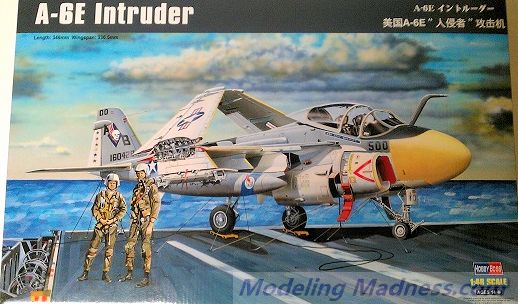
Hobby Boss 1/48 A-6E Intruder
| KIT #: | 81709 |
| PRICE: | $66.49 at Squadron (94.99 SRP) |
| DECALS: | Two options |
| REVIEWER: | Scott Van Aken |
| NOTES: |

| HISTORY |
The A-6E was the definitive attack version of the Navy's last dedicated bomber, the Intruder, with vastly upgraded navigation and attack systems, introduced in 1970 and first deployed on 9 December 1971. The earlier separate search and track (fire control) radars of the A-6A/B/C were replaced by a single Norden AN/APQ-148 multi-mode radar, and onboard computers with a more sophisticated (and generally more reliable) IC based system, as opposed to the A-6A's DIANE discrete transistor-based technology. A new AN/ASN-92 inertial navigation system was added, along with the CAINS (Carrier Aircraft Inertial Navigation System), for greater navigation accuracy.
Beginning in 1979, all A-6Es were fitted with the AN/AAS-33 DRS (Detecting and Ranging Set), part of the "Target Recognition and Attack Multi-Sensor" (TRAM) system, a small, gyroscopically stabilized turret, mounted under the nose of the aircraft, containing a FLIR boresighted with a laser spot-tracker/designator and IBM AN/ASQ-155 computer. TRAM was matched with a new Norden AN/APQ-156 radar. The BN could use both TRAM imagery and radar data for extremely accurate attacks, or use the TRAM sensors alone to attack without using the Intruder's radar (which might warn the target). TRAM also allowed the Intruder to autonomously designate and drop laser-guided bombs. In addition, the Intruder used Airborne Moving Target Indicator (AMTI), which allowed the aircraft to track a moving target (such as a tank or truck) and drop ordnance on it even though the target was moving. Also, the computer system allowed the use of Offset Aim Point (OAP), giving the crew the ability to drop on a target unseen on radar by noting coordinates of a known target nearby and entering the offset range and bearing to the unseen target.
In the 1980s, the A-6E TRAM aircraft were converted to the A-6E WCSI (Weapons Control System Improvement) version to add additional weapons capability. This added the ability to carry and target some of the first generation precision guided weapons, like the AGM-84 Harpoon missile, and AGM-123 Skipper. The WSCI aircraft was eventually modified to have a limited capability to use the AGM-84E SLAM standoff land attack missile. Since the Harpoon and SLAM missiles had common communication interfaces, WCSI aircraft could carry and fire SLAM missiles, but needed a nearby A-6E SWIP to guide them to target.
In the early 1990s, some surviving A-6Es were upgraded under SWIP (Systems/Weapons Improvement Program) to enable them to use the latest precision-guided munitions, including AGM-65 Mavericks, AGM-84E SLAMs, AGM-62 Walleyes and the AGM-88 HARM anti-radiation missile as well as additional capability with the AGM-84 Harpoon. A co-processor was added to the AN/ASQ-155 computer system to implement the needed MIL-SPEC 1553 digital interfaces to the pylons, as well as an additional control panel. After a series of wing-fatigue problems, about 85% of the fleet was fitted with new graphite/epoxy/titanium/aluminum composite wings. The new wings proved to be a mixed blessing, as a composite wing is stiffer and transmits more force to the fuselage, accelerating fatigue in the fuselage. In 1990, The decision was make to terminate production of the A-6. Through the 1970s and 1980s, the A-6 had been in low-rate production of four or five new aircraft a year, enough to replace mostly accidental losses. The final production order was for 20 aircraft of the SWIP configuration with composite wings, delivered in 1993. All Intruders had been retired by April of 1997, including those that were only four years old.
A-6E models totaled 445 aircraft, about 240 of which were converted from earlier A-6A/B/C models.
| THE KIT |
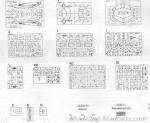 For
an aircraft that I rarely see on contest tables, the 1/48 A-6 has certainly
been kitted enough time. Fujimi was first with one way back when, followed
by Revell and more recently Kinetic and now Hobby Boss. Aside from the
Fujimi kit, which I understand is pretty crude, those by Revell and Kinetic
are pretty nice. I've only built the Revell version and found it to be an
acceptable kit that made a nice model.
For
an aircraft that I rarely see on contest tables, the 1/48 A-6 has certainly
been kitted enough time. Fujimi was first with one way back when, followed
by Revell and more recently Kinetic and now Hobby Boss. Aside from the
Fujimi kit, which I understand is pretty crude, those by Revell and Kinetic
are pretty nice. I've only built the Revell version and found it to be an
acceptable kit that made a nice model. 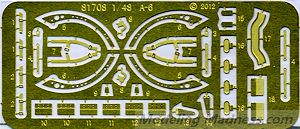 instrument panel and console detail is raised so you do not rely on decals
for details, though decals are supplied. The photo etch sheet that is
provided is mostly for the cockpit and canopy detailing.
instrument panel and console detail is raised so you do not rely on decals
for details, though decals are supplied. The photo etch sheet that is
provided is mostly for the cockpit and canopy detailing. 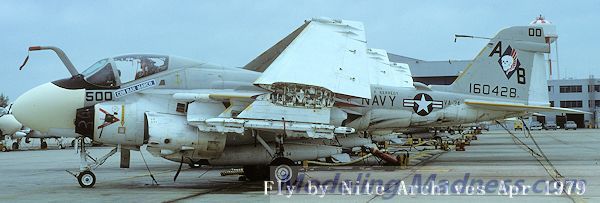 Kit instructions
are nicely done and provide color information using Gunze paints. There are
markings for two aircraft. One is an A-6E from VA-34. This is an early A-6E
without the TRAM pod under the nose. It is in the early light gull grey and
white scheme with a buff radome and is probably from about the same
Kit instructions
are nicely done and provide color information using Gunze paints. There are
markings for two aircraft. One is an A-6E from VA-34. This is an early A-6E
without the TRAM pod under the nose. It is in the early light gull grey and
white scheme with a buff radome and is probably from about the same
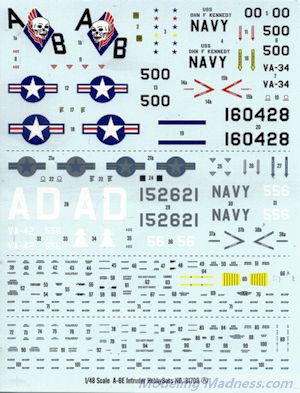 time
period as the photo I've provided, which would be the late 1970s when not
all A-6Es were outfitted with this system. The other is from VA-42, which
was the west coast
training squadron. This one is also lacking the TRAM pod. It is in the later tactical paint scheme which makes it
very hard to see any sort of markings. The decal sheet may have the dark
grey markings too dark with the lighter markings in white when they should
be a lighter grey. I have this photo taken a month or so before the plane
was lost so you can judge for yourself. Decals are provided on three sheets.
One is for the two markings options
and is shown. The other two are for missile stencils and the instrument
panel and are not shown. There are some glitches on the sheet. For the
time
period as the photo I've provided, which would be the late 1970s when not
all A-6Es were outfitted with this system. The other is from VA-42, which
was the west coast
training squadron. This one is also lacking the TRAM pod. It is in the later tactical paint scheme which makes it
very hard to see any sort of markings. The decal sheet may have the dark
grey markings too dark with the lighter markings in white when they should
be a lighter grey. I have this photo taken a month or so before the plane
was lost so you can judge for yourself. Decals are provided on three sheets.
One is for the two markings options
and is shown. The other two are for missile stencils and the instrument
panel and are not shown. There are some glitches on the sheet. For the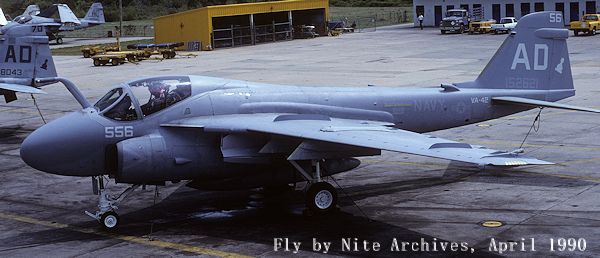 first
option, the carrier name is missing the J in John F. Kennedy and both
options have Rescue markings that are without the R. There are also no crew
names for the first option, just the banner on which they would be painted. You'll notice a few differences in the
thickness of the lettering for the 'NAVY' and the tail serial for the VA-34 option. Perhaps one of the many aftermarket decal sheets would be a better choice.
first
option, the carrier name is missing the J in John F. Kennedy and both
options have Rescue markings that are without the R. There are also no crew
names for the first option, just the banner on which they would be painted. You'll notice a few differences in the
thickness of the lettering for the 'NAVY' and the tail serial for the VA-34 option. Perhaps one of the many aftermarket decal sheets would be a better choice.
| CONCLUSIONS |
Overall, you have an excellent and very detailed kit of the Navy's last specialized bomber. There is a ton of ordnance to make it look properly bulked out and you don't have to buy a separate weapons set. Thanks to all the detail and all the options, this one will make a great model for your shelves. Shame about the decal glitches though.
| REFERENCES |
http://en.wikipedia.org/wiki/A-6E_Intruder#A-6E
July 2014
My thanks to Squadron Products for the preview kit. Get yours today
at this link.
If you would like your product reviewed fairly and fairly quickly, please contact the editor or see other details in the Note to Contributors.